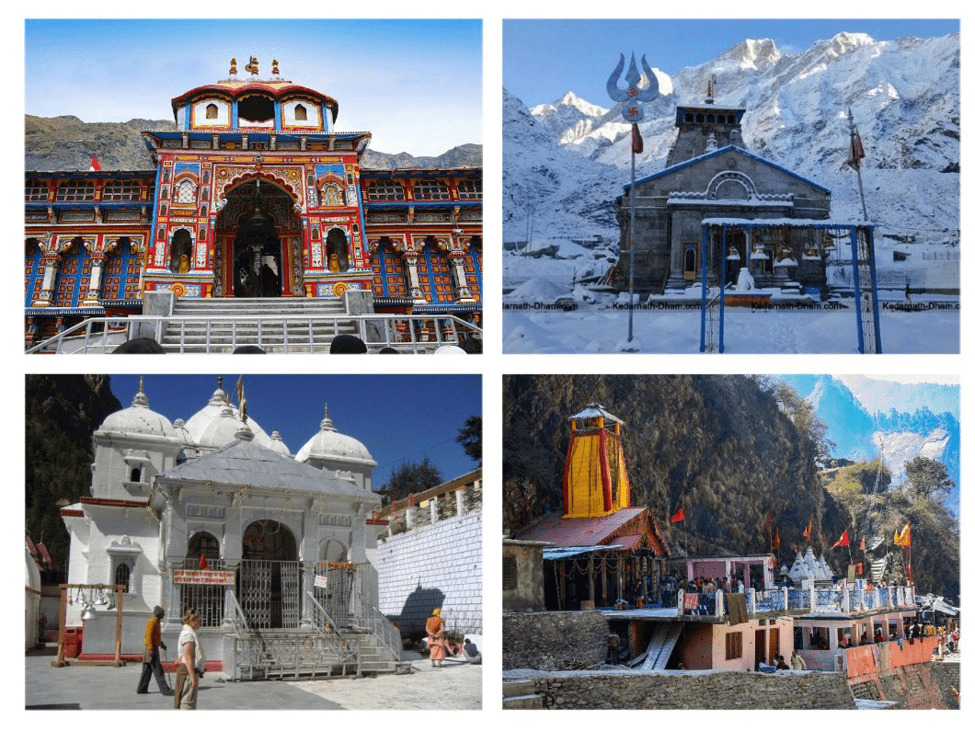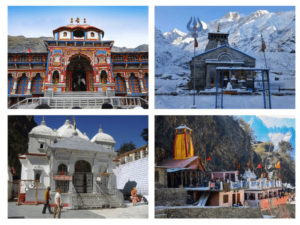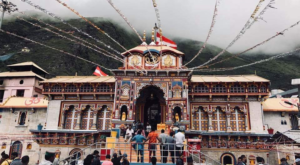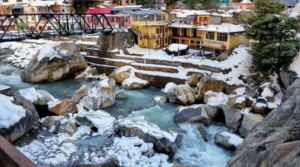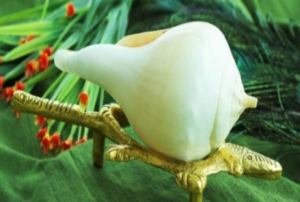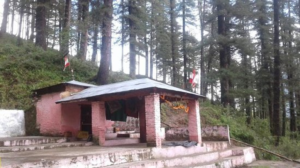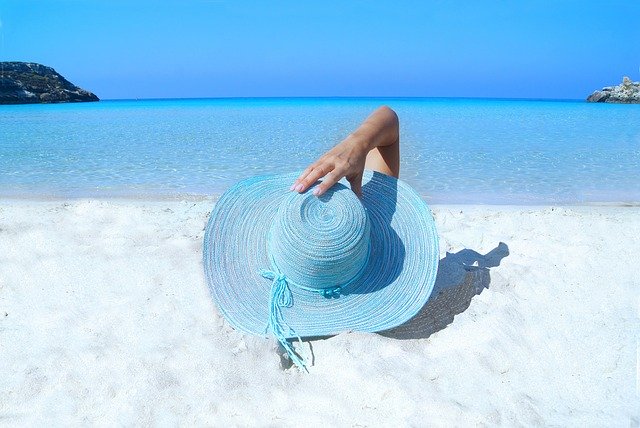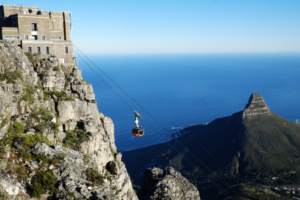It has been a long time since I have written an article here since COVID 19 and the lockdown. I came across this and wish to share the following with you-
The world is home to a plethora of fascinating ancient ruins, from crumbling cities to temples that have withstood the test of time. Many of these ancient societies were incredibly innovative and forward-thinking. Just take a look at their meticulous city planning and incredible feats of engineering; some of which we are yet to fully understand. And while there’s so much we can learn from these prehistoric people, perhaps the most enchanting part is what we don’t know. Some of the most captivating ancient ruins are full of thousand-year-old mysteries that will boggle even the most curious of minds.
25. Ayuthaya

Founded around the year 1350, Ayutthaya is a historical city that began as a Khmer military and trading post. It wasn’t long before this thriving trading port became the ancient capital of Thailand. It held onto this title for four centuries until it was burned down by Burmese invaders. As many of the temples and relics of the city were crafted from wood, the large majority were destroyed. Only around 50 stone relics and temples survived the fire and can still be seen today. Since renovations started in the 1970s, exploring Ayutthaya’s mix of Siamese, Sri Lankan and Khmer architecture has become a popular day trip from Bangkok.
24. Stonehenge
Dotted along the Salisbury Plain in Wiltshire, England, Stonehenge is easily one of the most recognized ancient ruins in the world. Dating back over 5,000 years, these curious stone rings are some of the oldest stone structures on the planet. Created out of sandstone, they are ensconced in mystery. Who built them and why is still largely unknown. Two popular theories maintain that Stonehenge was used as a site for religious rituals or otherwise to monitor the movements of the sun and moon. As you only need two hours to explore the ruins of Stonehenge and its adjacent museum, a day trip from London is often combined with a visit to Windsor or Bath.
23. Mesa Verde

Deep in the American Southwest, you’ll find Mesa Verde National Park with its fascinating collection of 600 ancient clifftop dwellings. The most famous of these dwellings is the Cliff Palace, built into an enormous sandstone alcove that’s protected it from the elements for over seven centuries. It’s the largest of its kind in North America and unlike the rest of the dwellings that contained just a few rooms for residential purposes, the palace had over 150 rooms and 23 sacred kivas. Having been lived in for close to a century, these unusual cliff-side villages were suddenly abandoned in the 13th-century.. Nobody really knows why. Today, around 4,800 archaeological sites dating back to 550 AD can be found in Mesa Verde, some of which are open to the public.
22. Sigiriya

flickr/Amila Tennakoon
Sigiriya is an ancient fortress carved into a 200-meter vertical rock face near the town of Dambulla in Sri Lanka. On top of what is now known as Lion Rock are the fascinating remains of an ancient civilization, thought to be the capital of the kingdom of Kassapa. In its heyday, it included a citadel, an upper palace, a mirror wall with stunning colorful frescoes, and a gateway in the shape of a lion. After the king passed, the capital was abandoned and it was used as a Buddhist monastery until the 14th-century. While the climb to the top of Sigiriya is certainly not for the faint-hearted, the views of the water features, ramparts, terraced gardens and cave shrines will be worth the effort.
21. Masada

wikipedia/Andrew Shiva
The ancient fortress of Masada is possibly one of the most impressive ruins on the planet. Perched on a cliff top overlooking the Judaean Desert and the Dead Sea in Israel, the site is hauntingly beautiful. Dating back over thousands of years, it was built as the palace of King Herod. It had modern creature comforts such as a bathhouse and even private swimming pools. More famously, the enormous fortification saw the last stand of the Jewish Revolt who chose death over a life of Roman slavery. Today, the military camps and battlements are the best-preserved examples of Roman siege works in history. Two pathways lead to the top and while grueling in the beating sun, the views are worth it!
20. Hampi

dreamstime/© Yana Sutina
The second-largest medieval city after Beijing, Hampi was one of the wealthiest in India. Once the thriving epicenter of the Karnata Empire with temples and imperial palaces, now only crumbling ruins remain. Founded in the 14th-century by two princes, the former capital began as a simple riverside religious center. Highlights include the temple that served as the royal family’s personal place of worship, the House of Victory, the Vitthala Temple with its stone chariot and musical pillars, and the main temple with its carvings of strange-looking sea creatures.
19. Pompeii

flickr/Carlo Mirante
The eerie ruins of Pompeii can be found near the Italian city of Naples. When the iconic Mount Vesuvius erupted in 79 AD, it destroyed the Roman city in waves of lava and took the lives of over 2,000 residents along with it. The ancient city first discovered by accident beneath the volcanic rock in the 1950s is remarkably well preserved. However, it wasn’t until two decades later that it was properly excavated. To this day, 22 of the original 66 hectares have not been unearthed. You can walk down the streets of these ancient Roman ruins and imagine the town as it was in its heyday. There are the remains of stone houses, temples, bakeries, and even a brothel.
18. Tulum

An hours’ drive from Cancun, the Tulum ruins are the remains of an ancient cliff top fortress built by the Mayans. Walled on three sides with the fourth open to the Caribbean Sea, the views are simply incredible. Even though it dates back to 564 AD, Tulum was at its prime during the 13th and 14th centuries. Home to just 1,600 residents, it was a powerful trading hub for turquoise, jade, cotton, and cacao beans. Apart from the El Castillo pyramid, the main attraction, have a look at the beautiful mural inside the Temple of the Frescoes and go for a swim at Tulum secret beach, surrounded by palm trees and sunbathing iguanas. While you’ll have your choice of guided tours, you’ll get far more out of exploring at your own pace. Self-guided books can be purchased at the entrance.
17. Ephesus

Despite being one of the most impressive Greek and Roman ruins on Earth, the ancient city of Ephesus can be found in western Turkey. Dating back over 2,000 years, it was once home to the famous Temple of Artemis. But what makes these ruins stand out is just how immersive they are. Unlike many other protected archaeological sites, you can touch, stand on and walk through every part of the city. Highlights include a series of ancient public toilets, the Library of Celsus, the Bath of Varius, Hadrian’s Temple, and the Prytaneion. It is also home to the 25,000-seater Great Theater of Ephesus, the largest outdoor theatre in the ancient world.
16. Ellora Caves
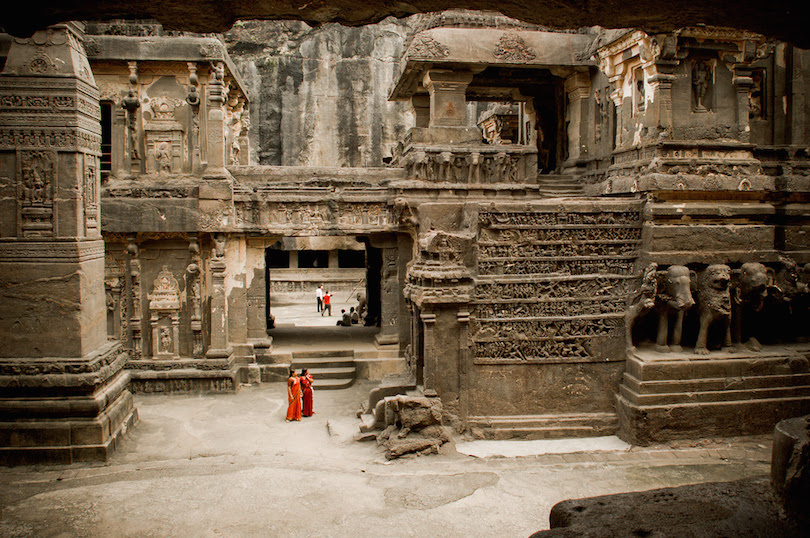
flickr/pichenettes
The Ellora Caves are made up of a series of caves, monasteries, chapels and temples carved into the side of a basalt cliff. Out of 100 caves, only 34 are open to the public. Located in Maharashtra, India, Ellora dates back to 600 AD and took Buddhist, Hindu and Jain monks over five centuries to craft. The highlight of the Ellora Caves is the Kailasa Temple. Dedicated to Lord Shiva, it is the largest monolithic sculpture in the world. Other worthy sights include the large preaching Buddha in the Carpenter’s Cave, so-called because of the rock’s resemblance to polished wood. Don’t miss the two enormous statues of Indra in the Chota Kailash Cave.
15. Terracotta Army

flickr/Pedro Szekely
The Terracotta Warriors, also known as the Terracotta Army, are an impressive collection of thousands of life-sized soldiers and horses. Located in Xi’an, China, near the tomb of Qin Shi Huangdi, there are around 600 underground pits dating back to the 3rd-century BC. They were discovered by accident in the 1970s when locals were digging for a well point. While many remain unexcavated, three of these pits are open to the public and are enclosed within the Museum of the Terracotta Army. Apart from their sheer volume, what’s interesting about these clay soldiers is that every single face is unique. They were hand-carved with individual features and took around 40 years of craftsmanship in total.
14. Chichen Itza
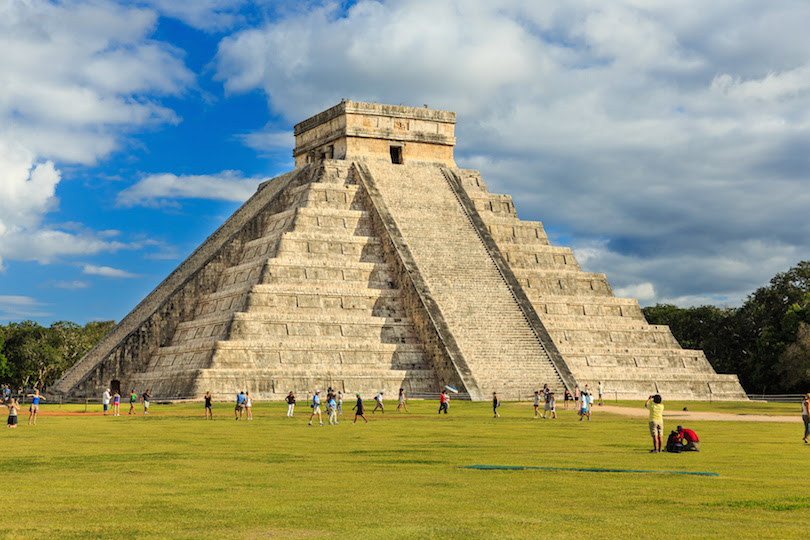
One of the most famous archaeological sites on Earth, Chichen Itza was once a thriving pre-Hispanic city on the Yucatan Peninsula. Built by the Mayans in 600 AD, it was abandoned in 1221 when Mayapan became the new capital. Highlights include the Temple of Kukulkan, a giant stone pyramid with four stairways representing a compass and 365 steps for each day of the year. It is best visited during the spring or fall equinox when the sun creates a light show on the stairs of the pyramid. Other must-see sites include the Temple of the Warriors, the Maya Ball Court, the Wall of Skulls, and the Sacred Cenote that was once a site of human sacrifice. As Chichen Itza is always crowded, it’s best in the early morning or just before closing.
13. Acropolis
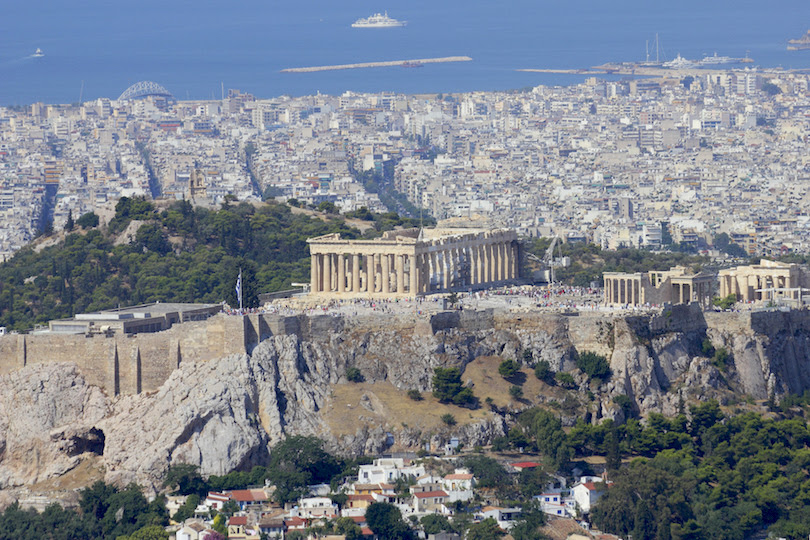
wikipedia/A.Savin
From its perch above the city of Athens, the Acropolis topped by the Parthenon can be seen from any corner of the city. First built and inhabited by Pericles in the 5th-century, the Acropolis was eventually transformed into a city of temples. These ancient structures were crafted out of bronze and Pentelic marble, and some were even gold plated. Restorations are still ongoing so don’t be surprised to find scaffolding still in place. Many of the original artefacts were relocated to the Acropolis Museum so this is worth a visit while you’re here. As the Parthenon stands in the beating sun, its best visited early in the morning or late at night. This is also when it is least crowded.
12. Bagan

The ancient city of Bagan is a captivating temple town in Myanmar. Once the capital of a powerful kingdom during the 11th and 13th centuries, it had over 10,000 temples, monasteries, shrines, pagodas, and stupas in its zenith. In the years since, these sacred sites have fallen into ruin as a result of Mongol invasions, neglect and natural disasters. Just 2,000 temple ruins remain and are scattered over the horizon. While you can explore the Bagan Archaeological Zone on foot, the sheer volume of temples is best appreciated from the air. A hot air balloon ride over Bagan is a worthy addition to the bucket list!
11. Tikal

With its grey temple-tops protruding through the lush canopy of the Guatemalan jungle, catching a glimpse of the ruins of Tikal is something truly special. A popular day trip from Flores or El Remate, these remote ruins are dotted with pyramids, temples and palaces. One of the largest archaeological sites in Mesoamerica, Tikal was the largest and most powerful of the Mayan cities around 600 AD. Don’t miss the Temple of the Two Headed Snake while you’re here. As one of the tallest pre-Columbian structures in the Western Hemisphere, climbing to the top will treat you to incredible 360-degree views of the rainforest and beyond.
10. Karnak

flickr/Mr. Theklan
The Karnak Temple complex in Luxor, Egypt, is impressive due to its sheer size. Covering an area that’s larger than most ancient cities, it’s dotted with temples, sanctuaries, obelisks, and shrines. It took over 2,000 years to build and each Egyptian pharaoh left their own architectural mark.. Walk through the Avenue of Sphinxes and discover the Great Hypostyle Hall.. This enormous room filled with towering pylons and solid sandstone columns is one of the most famous and photographed attractions of Ancient Egypt. While you’re here, stop to admire the Sacred Lake and the nearby granite scarab. It’s said that if you encircle it seven times, you will have good luck in love.
9. Borobudur

Crafted out of an impressive two million blocks of volcanic stone, Borobudur in Indonesia is the largest Buddhist temple in the world. Dating back to the 9th-century, it eventually fell into ruin until it was discovered again in the 1800s. Since then, it has been restored to its former glory and is particularly popular at sunrise. The Borobudur monument consists of six square platforms topped by three circular platforms. A pathway of enlightenment leads from the base of the pyramid up through the three levels of Buddhist cosmology, the world of forms, and the world of formlessness. It’s decorated with over 2,000 reliefs and 500 Buddha statues, each one outlining a Buddhist teaching.
8. Teotihuacan
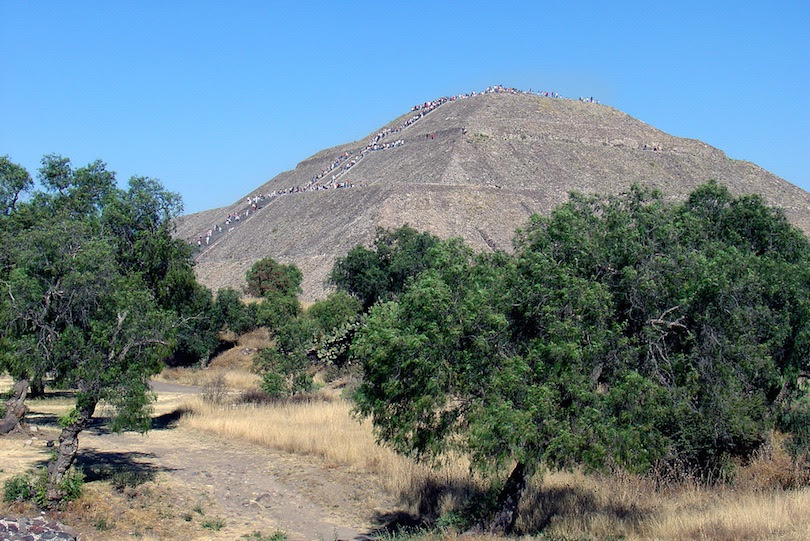
flickr/ZeroOne
Located on the outskirts of modern-day Mexico City, Teotihuacan is one of the most famous Aztec archaeological sites. But the Aztecs didn’t actually build it. Despite many theories, nobody is really sure who did. However, the Aztecs did name it and make it their own when they stumbled across the abandoned city. In its prime, it was the largest city in the Western Hemisphere and home to a plethora of residential compounds and pyramids; some of which were as big as the Pyramids of Giza. Today, its two iconic pyramids, the Temple of the Sun and the Temple of the Moon, are the major highlights. Stroll along the Avenue of the Dead and visit the Citadel and the Temple of the Feathered Serpent.
7. Moai Statues

With the tallest weighing in over 80 tonnes, the Moai Statues on Easter Island in Polynesia are iconic. In fact, you’ll probably recognize them from a picture even if you hadn’t heard of them. These 800-plus statues, most of which face away from the sea, were carved from volcanic ash by the Rapa Nui people somewhere between 400 and 1500 AD. Likely created using rudimentary basalt stone picks, each of these enormous monolithic statues would have taken close to a year to complete. There are many theories as to why they were built, including as a way to honor important clan ancestors and because of a believe it would improve the soil.
6. Colosseum
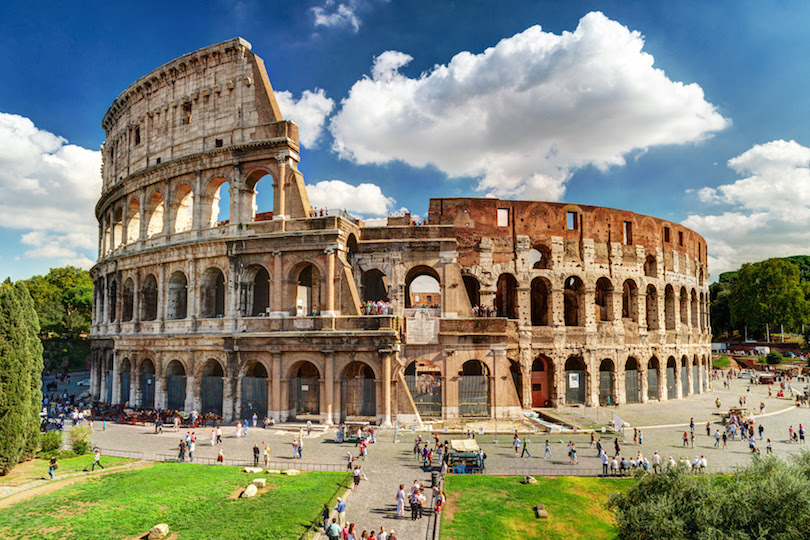
One of the most iconic Roman ruins, the Colosseum was an ancient gladiator arena. Unveiled in 80 AD, the 50,000-seater amphitheater was used for staging various events. These included animal fights and blood-thirsty gladiator contests where contestants would fight to the death. The architecture of the Colosseum is impressive even by today’s standards. The outer walls are made up of three levels of archways topped with Ionic, Doric and Corinthian columns. In its hey-day, they were decorated with travertine and marble statues. The top level once supported an enormous awning that sheltered spectators from the elements. Today, you can explore the Colosseum itself or combine it with a visit to the nearby Roman Forum and Palatine Hill.
5. Great Wall of China

Wikipedia/Severin.stalder
Spreading through 15 Chinese provinces, principalities and autonomous regions, the Great Wall of China is the longest man-made structure in the world. It is made up of a series of separate sections of walls and moats that were built over the course of six Chinese dynasties as a defense from invaders. Now well over 2,000 years old, some parts of the wall have fallen into ruin. Interestingly, for those who wanted to attempt it, walking the entire length of the Great Wall of China would take approximately 18 months.
4. Petra
The Rose City of Petra is an ancient desert town that was carved out of pink sandstone cliffs by nomads thousands of years ago. Located in Jordan, tucked between the Red Sea and the Dead Sea, it’s hard to believe the city was once filled with green gardens, palatial houses, and bustling markets. Instead, a walk, camel or donkey ride through the ruins of Petra will reveal abandoned caves, temples, and tombs hidden within the city walls. The two-story Treasury carved into the rock face is one of the most beautiful landmarks in the old city. It’s worth viewing for the facade alone but the interior with its Indiana-Jonesy royal tomb is worth a look. To this day, as much as 95% of the ancient city of Petra remains undiscovered.
3. Machu Picchu
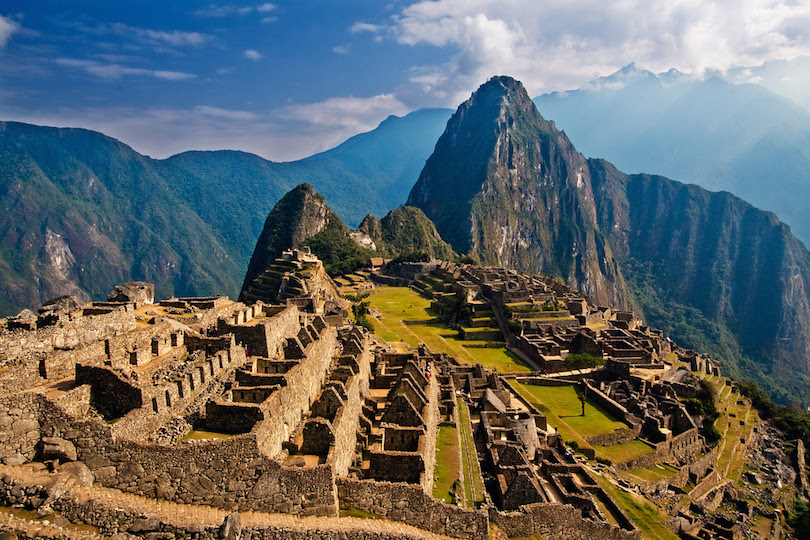
flickr/Pedro Szekely
A huge tick off the travel bucket list, Machu Picchu is one of the most famous cities of the ancient Incan Empire. This historical fortress lies hidden in the mountains of Peru. So well hidden in fact that it was never found by Spanish invaders when they arrived in the 1500s. They were only found in 1911 by an explorer called Bingham and even this was by accident. He was actually tracing another city known as Vilcabamba. A wonder of advanced engineering, it’s estimated that 60% of the construction was built underground, mainly for fortification and drainage. Today, these walled ruins can only be reached by foot or by train. Don’t miss the secret Machu Picchu Museum for an insider’s look into the Lost City of the Incas.
2. Angkor

Derived from the Sanskrit word ‘nagara’, Angkor means ‘city’. Once the capital of the Khmer Empire between the 9th and 15th centuries, it was a thriving ancient metropolis. Today, Angkor is most famous for its Hindu Angkor Wat Temple that claims the title as the largest religious shrine on Earth. It’s famously visited at sunrise when the lighting over the temples is simply magical. But the Angkor Archaeological Park actually includes many more fascinating landmarks aside from Angkor Wat. Over 1,000 temples lie scattered throughout the forest, rice fields and farmlands.. Highlights include the jungle-clad and mysterious Beng Mealea Temple with its early library and well-preserved carvings and the 12th-century Bayon Temple that marks the historical center of the ancient city of Angkor Thom.
1. Giza

dreamstime/© Meuniere
One of the most mysterious ancient sites on Earth, the Pyramids of Giza in Cairo are truly fascinating. Created as enormous tombs for the pharaohs of Ancient Egypt in the Fourth Dynasty, there’s plenty of speculation as to how they were built. With such precise and immaculate detail, they’re yet another remarkable feat of ancient Egyptian engineering. In fact, many believe they were built by angels or even aliens. Visitors can pay to enter all three of the great pyramids. They were used as burial chambers and were littered with treasure for the Pharaoh to use in the afterlife – something that attracted many a grave robber over the years. Don’t forget to get a kissing photo with the Sphinx – it’s pretty much mandatory. For those looking to escape the worst of the crowds, there are many more lesser-known tombs, temple ruins and pyramids worth exploring in the surrounding desert plateau.

